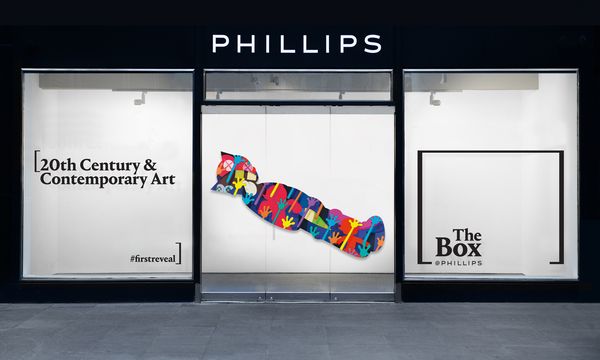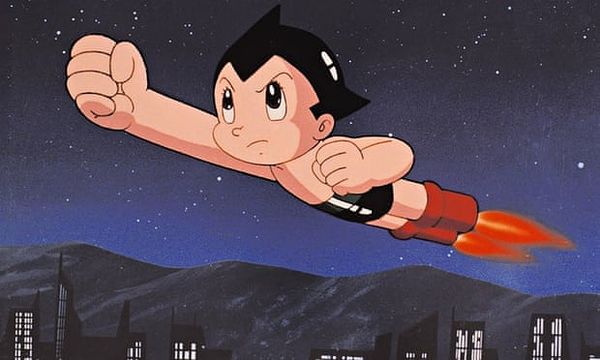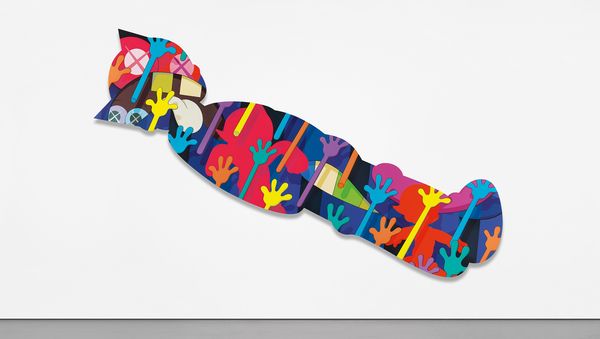An idiosyncratic portrayal of one of Japan’s most iconic cartoon characters, UNTITLED, 2014 exemplifies KAWS’s ability to blur abstraction and figuration, collapsing conventional distinctions between high and low culture. The present work depicts the larger-than-life silhouette of Astro Boy suffused with the disparate cartoon elements that comprise KAWS’s visual lexicon. Astro Boy, a manga series written and illustrated by Osamu Tezuka, was published in the magazine Shōnen from 1952 to 1968 and has since been adapted into four anime series with unprecedented global appeal. Emblematic of KAWS’s engrossment with cartoon imagery, the kaleidoscopic palette, chaotic energy and hard-edge technique of UNTITLED are also evocative of his time as a street artist in New York in the 1990s, during which he transformed preexisting advertisements by incorporating his own aesthetic language.
The tale of Tezuka’s Astro Boy follows a sentient android that is saved from a cruel circus owner by Professor Ochanomizu, who subsequently treats Astro as a son, helping him to lead a normal, human life. The comics have sold approximately 100 million copies, and the first television series is credited with instigating the phenomenon known worldwide as “anime.” Astro Boy was also the first Japanese animated television series to be viewed on American screens, and its success abroad made Astro Boy an instantly-recognizable worldwide phenomenon.
Astro Boy © Osamu Tezuka
KAWS first visited Tokyo in 1997, at a time when his tags were gaining notoriety in New York and New Jersey. While in Japan, KAWS was struck by the ability for cartoons to bridge cultural differences and language barriers. “It was difficult to communicate since I didn’t speak Japanese, but I could walk down the streets and see shops full of Simpsons merchandise,” he explained. “It was like, ‘You know Homer, I know Homer.’ We might not be able to have a meaningful conversation, but to all of us, it’s still Homer” (KAWS, quoted in KAWS: WHERE THE END STARTS, exh. cat., Modern Art Museum of Fort Worth, Fort Worth). KAWS returned to Japan often in the early 2000s, a formative period in his career: he painted his first acrylic on canvases in 2001, and opened his collectibles store, OriginalFake, in 2006.
Although an iconic cartoon character seems like a seamless portrait of a cartoon personality, it is in fact made up of eccentrically formed parts: mouths, eyes, ears, hands…Looking carefully at cartoons reveals a fundamental part-to-whole construction. — Michael Auping
KAWS UNTITLED, 2014
UNTITLED denotes a gradual progression from KAWS’s earlier works depicting coherent narratives specific to well-known personages, such as Mickey Mouse and the Simpsons, to more deconstructed, ambiguous compositions. Though Astro Boy’s profile and distinctive haircut inform the shape of the canvas, UNTITLED is replete with numerous other references and abstract forms. While some are recognizable, including eyes marked with the artist’s signature X’s, as well as a sea of dismembered hands referencing his paintings of SpongeBob SquarePants, others are more abstract, such as the eye-like configuration between his legs. “Although an iconic cartoon character seems like a seamless portrait of a cartoon personality, it is in fact made up of eccentrically formed parts: mouths, eyes, ears, hands…Looking carefully at cartoons reveals a fundamental part-to-whole construction,” curator Michael Auping has elucidated (Michael Auping, KAWS: WHERE THE END STARTS, exh. cat., Modern Art Museum of Fort Worth, Fort Worth). In this sense, KAWS has subverted the very presence of Astro Boy in UNTITLED, unearthing the poignant humanity hidden in cartoons.
By coalescing cartoon imagery with ambiguous abstract forms, KAWS embraces kitsch and rejects Clement Greenberg’s modernist consecration of pure abstraction. Like Warhol, who similarly worked as an illustrator before transitioning to fine art, KAWS champions the immense communicative power of the everyday and investigates the global experience of television and mass media. The large-scale manifestation of his preoccupation with Astro Boy in UNTITLED, as well as its fusion of “high” and “low” art, is a tribute to one of the most conspicuous influences on his oeuvre: Japanese visual culture.
Inquiries
Amanda Lo Iacono
Head of Evening Sale
aloiacono@phillips.com
+1 212 940 1278


